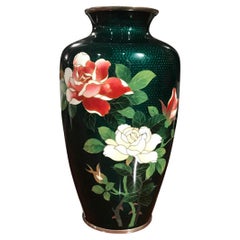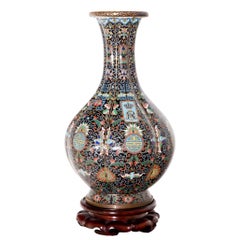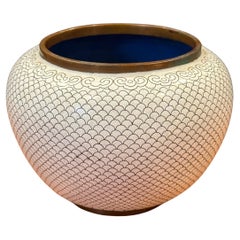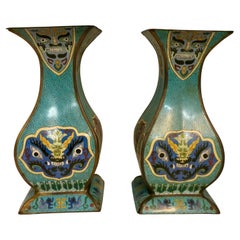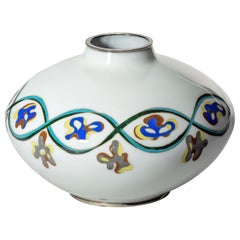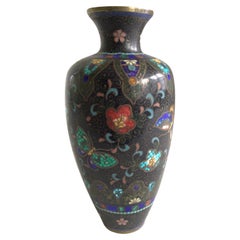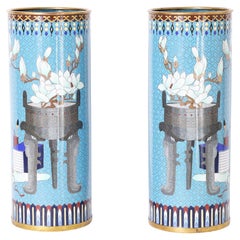Cloisonne Vases
Vintage 1920s Vases
Glass
Antique Early 1900s Asian Vases
Metal
Mid-20th Century Chinese Vases
Brass, Enamel
Early 20th Century Japanese Vases
Metal, Enamel
Vintage 1910s Metalwork
Vintage 1980s Japanese Showa Vases
Enamel
Early 20th Century Chinese Vases
Enamel
Vintage 1920s Chinese Vases
Brass, Enamel
Early 20th Century Chinese Chinese Export Vases
Metal
Antique 19th Century Chinese Chinese Export Planters, Cachepots and Jard...
Enamel
Vintage 1960s Japanese Metalwork
Vintage 1980s Chinese Vases
Copper
Early 20th Century Chinese Qing Antiquities
Bronze
Antique Early 1900s Japanese Meiji Vases
Enamel, Silver
Antique Late 19th Century Japanese Meiji Vases
Bronze
Antique Early 1900s Japanese Japonisme Vases
Metal
Antique Early 1900s French Mid-Century Modern Vases
Ceramic
Mid-20th Century Chinese Regency Vases
Brass, Enamel
Antique 19th Century Chinese Vases
Copper
Vintage 1980s Japanese Vases
Enamel
21st Century and Contemporary Japanese Vases
Metal, Bronze, Copper
Vintage 1920s Chinese Vases
Brass, Enamel
Antique 19th Century Chinese Qing Vases
Mid-20th Century Japanese Vases
Bronze, Enamel
20th Century Chinese Qing Vases
Enamel, Bronze
Vintage 1960s Hong Kong Vases
Brass
Mid-20th Century Chinese Chinese Export Vases
Brass, Enamel
Late 20th Century Japanese Vases
Enamel
Vintage 1920s Chinese Other Vases
Metal
Antique 19th Century Antiquities
Porcelain
Antique Mid-19th Century Chinese Bottles
Metal
Early 20th Century Japanese Meiji Vases
Enamel
Antique Late 19th Century Asian Table Lamps
Porcelain
Antique 1890s Japanese Chinoiserie Vases
Bronze
Mid-20th Century Chinese Chinese Export Vases
Copper
20th Century Chinese Chinese Export Vases
Copper
Mid-20th Century Chinese Chinese Export Vases
Metal, Copper
20th Century Japanese Ceramics
Ceramic
Mid-20th Century Japanese Mid-Century Modern Vases
Metal
Vintage 1950s Japanese Showa Ceramics
Ceramic
Mid-20th Century Chinese Vases
Brass, Enamel
Antique Late 19th Century Japanese Aesthetic Movement Vases
Silver, Enamel
Antique Late 19th Century Chinese Chinese Export Table Lamps
Enamel
20th Century Japanese Meiji Vases
Enamel, Metal
Vintage 1970s Chinese Metalwork
Metal, Enamel
Early 20th Century Chinese Chinese Export Vases
Copper
Early 20th Century Japanese Meiji Vases
Metal
20th Century Japanese Showa Vases
Metal, Enamel
Vintage 1920s Chinese Vases
Enamel
Mid-20th Century Japanese Showa Ceramics
Ceramic
Early 20th Century Ceramics
Ceramic
Antique Late 19th Century Japanese Meiji Vases
Enamel
20th Century Chinese Vases
Bronze
Early 20th Century Metalwork
Metal, Enamel
Early 20th Century Japanese Vases
Enamel
Early 20th Century Japanese Vases
Enamel
Early 20th Century Chinese Vases
Metal
20th Century Japanese Meiji Vases
Metal, Enamel
Mid-20th Century Chinese Chinese Export Vases
Metal, Enamel
Mid-20th Century Japanese Showa Ceramics
Ceramic
- 1
- ...
Antique Cloisonné Vases for Sale on 1stDibs
Liven your home with cloisonné vases, bowls, lamps and other objects and furnishings ornamented with lustrous enamel. Technically, enamel is colored glass fused to metal. But that simple description greatly understates the case.
Applied using an array of techniques to a wide range of objects, enamel is one of the most dynamic, and alluring, mediums in the world. And as ceramic vases and other decorative vessels are gaining popularity again — the personalization of handmade craftsmanship has served as a sort of anti-Internet to screen-weary interior designers — antique cloissonné vases can help introduce interesting colors and patterns to your space.
No one knows for sure when or where enameling originated. But, according to the Encyclopedia Britannica, it is widely believed that the decoration on a gold scepter found in a royal Mycenaean tomb at Kourion Kaloriziki, in Cyprus, and dating to the 11th century BC, is a true, early example of the technique.
Between the 6th and 12th centuries AD, cloisonné — in which tiny compartments (cloisons) made by soldering copper filaments to a metal surface are filled with vibrantly hued enamel — had a huge vogue in the Byzantine Empire. By the 7th century, Lombard craftsmen in northern Italy were using enamel to emulate Byzantine objects. In the 12th and 13th centuries, artisans in China imported the technique and made it so much their own that enameled objects have long been associated with Eastern aesthetics and motifs rather than Western ones.
Collectors of authentic antique Chinese furniture and decorative objects know that Ming dynasty-era cloisonné objects are particularly coveted. Although ornamentation was minimal at the time, Ming dynasty furniture often featured carved or painted details of flowers, insects, dragons, fruits and other motifs. As overseas trade expanded, techniques from the West, like cloisonné enamel painting, adorned table screens and other pieces.
Elaborately decorated Ming-era cloisonné objects and furnishings — vessels and other items featuring lots of vibrant colors and details — are likely to fetch considerable sums at auction, as Chinese cloisonné vases created during the Ming and Qing eras represent a golden age of the country’s furniture design. (Victorian cloisonné is also popular with design enthusiasts.)
Cloisonné wasn’t adopted in Japan until the 1800s. Back then, amid an era of societal and cultural shifts, a bolstered interest in art and design elevated Japanese craft traditions during the Meiji period. European styles like Japonisme appropriated Japanese design while craftsmen in places like Wales and England employed japanning, a varnishing technique that approximated the appearance of lacquer for the surfaces of furnishings.
Today, Meiji-era cloisonné vases or incense burners in good condition are of great interest to collectors of Asian art and furniture produced by the period’s Japanese cloisonné workshops.
Find antique cloisonné vases and other cloisonné objects for sale on 1stDibs.
- What is vintage cloisonne?1 Answer1stDibs ExpertApril 5, 2022In jewelry terms, a piece that is between 50 and 100 years old is considered vintage. Cloisonne jewelry is made by filling in tiny pockets or cloisons with ground glass, oxides and colorful enamels. This means that a piece of cloisonne jewelry that is 50-100 years old would be considered vintage. Shop a collection of vintage cloisonne from some of the world’s top sellers on 1stDibs.
- What is cloisonne vase?1 Answer1stDibs ExpertApril 5, 2022Cloisonné is a process for decorating objects by using metal strips or wire to create a design that is then filled in with enamel. Gemstones and colored glass can also be used in the design work, but would have to be cut down to size. This process produced vibrant intricate designs, which would especially be seen on vases. You’ll find a variety of cloisonné pieces from some of the world’s top sellers on 1stDibs.
Read More
Kazuyo Sejima’s Flowering Tree Blooms Year-Round
The brilliantly simple design turns a modest bouquet into a major statement.
He Wrote ‘Oedipus Rex,’ but Do You Know What He Looked Like?
The Greek tragedian is said to have been handsome in his day.
Cigar Culture Was Once the Peak of Masculinity. Now, It’s a Compelling Curiosity
Even for those who don’t indulge, elegant smoking accessories and audacious art portraying cigar enthusiasts hold a nostalgic allure.
African Travel Plans on Hold? This Ardmore Leopard Vase Brings the Beauty of the Savanna to You
It’s an excellent example of the sought-after ceramics coming out of South Africa’s KwaZulu-Natal province.
With a High-Tech Flagship and Cool Collabs, Lladró Is Breaking the Mold for Porcelain Production
Thanks to its new leadership, the Spanish maker of figurines, busts and lighting is on a mission to update the art of porcelain for the 21st century.
Zoë Powell’s Magnolia 05 Vessel Is Handmade from Clay She Unearthed Herself
The free-form stoneware piece is inspired by the magnolia tree and its associations with home.
8 Ways to Breathe New Life into a Space with Plants
The pair behind the Instagram account @houseplantclub share their tips for making any room of the house gloriously green.
Paris Gallerist Sandy Toupenet Gets Fired Up over 20th-Century Ceramics and Inventive New Makers
Her space on the city’s Left Bank mixes mid-century pieces by the likes of Jean Cocteau and Pablo Picasso with whimsical contemporary creations.
